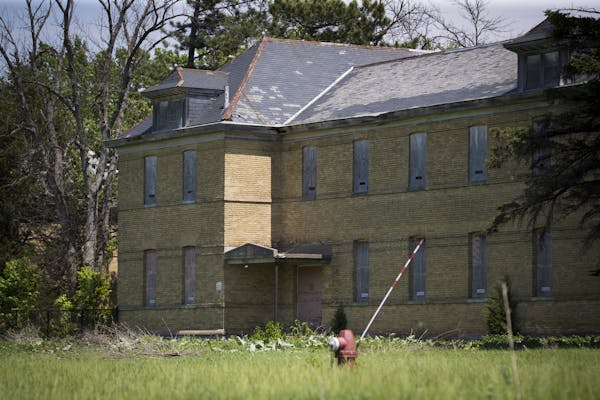One eye-popping detail stuck out in our story from last week about a plan to renovate historic Fort Snelling buildings into 176 affordable apartments for veterans, at a cost of $600,000 per unit.
That's the $28.4 million fee the proposed developer, a firm called Dominium of Plymouth, received for pulling together a similar development several years ago at the historic Pillsbury A-Mill in Minneapolis.
That kind of money for the deal promoter seems likely to be one reason this whole thing at the fort is proposed to cost so much. But it's never been my approach to complain loudly about the price of nice things after looking into them and concluding that's just what such things cost.
This proposed Fort Snelling project is expensive because it would do two things at once, creating some affordable places to live and restoring very old buildings to 2018 standards.
As for the work of Dominium, well, this isn't the kind of project novices should take on. It's a good idea to take a closer look at the project now called the A-Mill Artist Lofts, not to show how one firm made a lot of money (it probably hasn't, at least not yet) but as an illustration of how these things come together.
The Pillsbury A-Mill is probably the best-known reminder of the glory days of Minneapolis as a center for flour milling. It stands across the river from downtown Minneapolis, near the Falls of St. Anthony.
Among its recent owners was a real estate firm controlled by one of my brothers, and that's how I once received a private tour. It's so important to our economic history that it's had the rare status as a National Historic Landmark since the 1960s.
But to state the obvious, anyone interested in developing an efficient apartment building wouldn't go near it.
Unfortunately, there isn't a barrel of money anyone could tap for a $100 million grant to simply restore it. What it needed was private investment, but because it was a terrible real estate investment, why would investors jump aboard? The answer, of course, is tax credits.
In a simple real estate project, a spreadsheet that lists all the sources of money could be just two lines, the developer's own checkbook for the equity and then a first mortgage. As a result of the tax credits involved, the financing for the A-Mill project was complicated to the point of Byzantine, with 14 lines for sources of capital, according to a city of Minneapolis work sheet.
By far most of the $181 million, though, came from just a handful of buckets.
About $51.5 million came from selling low-income housing tax credits. There's a cash market for these credits, and obviously they are valuable only to investors with federal income tax obligations. Investors snapped up a similar amount of federal and state historic tax credits.
Another source of money was nearly $26 million of so-called hard debt, an odd term that means just that it's borrowed first mortgage money that the owners really must pay back.
The last big line in the sources of funds listing is the genuinely odd one, though, a whopping "deferred developer fee" that was bigger than the mortgage. So what's that and what's meant by deferred?
This is how a developer makes money on these projects. Dominium's role here is a little like the producer of a Hollywood movie, who hires a director and scriptwriter, secures distribution of the finished movie and pulls together all the financing to pay for it all. Dominium has a long track record at projects like this.
One reason to propose a big fee is that it contributes to the cost of the project, making it a bigger deal and thus generating more tax credits and investor capital. But it was listed as "deferred" on that spreadsheet. That means there wasn't enough money in the partnership to have paid it.
The tenants do pay rent, of course, but this is supposed to be affordable, so the rent checks aren't going to be enough to cover much other than the operating costs and payments on that relatively small mortgage. Any cash left over can go to other obligations, including that deferred developer's fee.
An even odder aspect of this project is that developers like Dominium usually make a lot of promises to investors brought into the deal. These investors bought a tax credit, not a building. They don't want to hear about a leaky roof and they sure don't want to help pay any old bills.
If there hasn't been enough cash flow to pay all the developer fees by the end of the tax credit period, Dominium is almost certainly going to be required to put money into the partnership to satisfy that obligation. Yes, that means it would be paying itself.
No one should feel sorry for Dominium, though. It's put in the work and took some risk here, but if it all works out, down the road when the tax credits end it will have control of a renovated national landmark.
It's certainly fair to say that the mill would still be standing without this renovation. It's a national landmark in the heart of our state's biggest city, and not going anywhere. And whether the old buildings at the fort are nearly as valuable in our shared history is a question for the better qualified.
Yet what's happened at the A-Mill and what's proposed for the fort sure seems to beat the alternative — just more decay while the scramble for affordable housing gets even worse.
lee.schafer@startribune.com 612-673-4302

Schafer: What do you really need to retire?

Schafer: How doing business can be a bit more like Christmas morning

Schafer: There won't soon be another opportunity to rethink the I-94 corridor

Schafer: The fruits of Honeywell's long-game dedication to quantum computer now being seen


